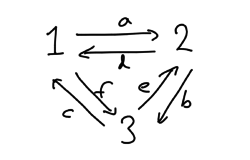Difference between revisions of "M(4,2,3)"
| (2 intermediate revisions by the same user not shown) | |||
| Line 8: | Line 8: | ||
|l(B) = 3 | |l(B) = 3 | ||
|k-morita-frob = 1 | |k-morita-frob = 1 | ||
| − | |Pic-k= <math>(k^* \times k^* \times C_3):C_2</math> | + | |Pic-k= <math>(k^* \times k^* \times C_3):C_2</math><ref>This is an elementary calculation.</ref> |
|cartan = <math>\left( \begin{array}{ccc} | |cartan = <math>\left( \begin{array}{ccc} | ||
2 & 1 & 1 \\ | 2 & 1 & 1 \\ | ||
| Line 26: | Line 26: | ||
|O-morita-frob = 1 | |O-morita-frob = 1 | ||
|Pic-O = <math>\mathcal{T}(B)=S_3</math><ref>Every Morita equivalence is a source algebra equivalence by [[References|[CEKL13]]], so <math>{\rm Pic}(B)=\mathcal{T}(B)</math></ref> | |Pic-O = <math>\mathcal{T}(B)=S_3</math><ref>Every Morita equivalence is a source algebra equivalence by [[References|[CEKL13]]], so <math>{\rm Pic}(B)=\mathcal{T}(B)</math></ref> | ||
| − | |PIgroup = <math>S_4 \times C_2</math> | + | |PIgroup = <math>S_4 \times C_2</math><ref>See, for example, Proposition 2.8 of [[References|[EL18a]]]</ref> |
|source? = Yes | |source? = Yes | ||
|sourcereps = <math>\mathcal{O}A_4</math> | |sourcereps = <math>\mathcal{O}A_4</math> | ||
| Line 32: | Line 32: | ||
|k-derived = [[M(4,2,2)]] | |k-derived = [[M(4,2,2)]] | ||
|O-derived-known? = Yes | |O-derived-known? = Yes | ||
| − | |coveringblocks = [[M(4,2,1)]]<ref>For example consider block number 2 of <math>PSL_3(7) \triangleleft PGL_3(7)</math> in the labelling used in [http://www.math.rwth-aachen.de/~MOC/decomposition/tex/L3(7)/]. The covering block of <math>PGL_3(7)</math> is nilpotent.</ref>, M(4,2,3) | + | |coveringblocks = [[M(4,2,1)]]<ref>For example consider block number 2 of <math>PSL_3(7) \triangleleft PGL_3(7)</math> in the labelling used in [http://www.math.rwth-aachen.de/~MOC/decomposition/tex/L3(7)/]. The covering block of <math>PGL_3(7)</math> is nilpotent.</ref>, M(4,2,3) (complete) |
| − | |coveredblocks = [[M(4,2,1)]], M(4,2,2) | + | |coveredblocks = [[M(4,2,1)]], M(4,2,2) (complete) |
| − | |pcoveringblocks = [[M(8,5,3)]] (complete)<ref> | + | |pcoveringblocks = [[M(8,3,3)]], [[M(8,5,3)]] (complete)<ref>A covering block cannot have defect group <math>C_4 \times C_2</math>.</ref> |
}} | }} | ||
Latest revision as of 16:29, 22 November 2018
| Representative: | [math]kA_4[/math] |
|---|---|
| Defect groups: | [math]C_2 \times C_2[/math] |
| Inertial quotients: | [math]C_3[/math] |
| [math]k(B)=[/math] | 4 |
| [math]l(B)=[/math] | 3 |
| [math]{\rm mf}_k(B)=[/math] | 1 |
| [math]{\rm Pic}_k(B)=[/math] | [math](k^* \times k^* \times C_3):C_2[/math][1] |
| Cartan matrix: | [math]\left( \begin{array}{ccc} 2 & 1 & 1 \\ 1 & 2 & 1 \\ 1 & 1 & 2 \\ \end{array} \right)[/math] |
| Defect group Morita invariant? | Yes |
| Inertial quotient Morita invariant? | Yes |
| [math]\mathcal{O}[/math]-Morita classes known? | Yes |
| [math]\mathcal{O}[/math]-Morita classes: | [math]\mathcal{O}A_4[/math] |
| Decomposition matrices: | [math]\left( \begin{array}{ccc} 1 & 0 & 0 \\ 0 & 1 & 0 \\ 0 & 0 & 1 \\ 1 & 1 & 1 \\ \end{array}\right)[/math] |
| [math]{\rm mf}_\mathcal{O}(B)=[/math] | 1 |
| [math]{\rm Pic}_{\mathcal{O}}(B)=[/math] | [math]\mathcal{T}(B)=S_3[/math][2] |
| [math]PI(B)=[/math] | [math]S_4 \times C_2[/math][3] |
| Source algebras known? | Yes |
| Source algebra reps: | [math]\mathcal{O}A_4[/math] |
| [math]k[/math]-derived equiv. classes known? | Yes |
| [math]k[/math]-derived equivalent to: | M(4,2,2) |
| [math]\mathcal{O}[/math]-derived equiv. classes known? | Yes |
| [math]p'[/math]-index covering blocks: | M(4,2,1)[4], M(4,2,3) (complete) |
| [math]p'[/math]-index covered blocks: | M(4,2,1), M(4,2,2) (complete) |
| Index [math]p[/math] covering blocks: | M(8,3,3), M(8,5,3) (complete)[5] |
Contents
Basic algebra
Quiver: a:<1,2>, b:<2,3>, c:<3,1>, d:<2,1>, e:<3,2>, f:<1,3>
Relations w.r.t. [math]k[/math]: ab=bc=ca=0, df=fe=ed=0, ad=fc, be=da, cf=eb
Other notatable representatives
Block number 2 of [math]k PSL_3(7)[/math] in the labelling used in [2]
Projective indecomposable modules
Labelling the simple [math]B[/math]-modules by [math]S_1, S_2, S_3[/math], the projective indecomposable modules have Loewy structure as follows:
[math]\begin{array}{ccc} \begin{array}{ccc} & S_1 & \\ S_2 & & S_3 \\ & S_1 & \\ \end{array}, & \begin{array}{ccc} & S_2 & \\ S_1 & & S_3 \\ & S_2 & \\ \end{array}, & \begin{array}{ccc} & S_3 & \\ S_1 & & S_2 \\ & S_3 & \\ \end{array} \end{array} [/math]
Irreducible characters
All irreducible characters have height zero.
Back to [math]C_2 \times C_2[/math]
Notes
- ↑ This is an elementary calculation.
- ↑ Every Morita equivalence is a source algebra equivalence by [CEKL13], so [math]{\rm Pic}(B)=\mathcal{T}(B)[/math]
- ↑ See, for example, Proposition 2.8 of [EL18a]
- ↑ For example consider block number 2 of [math]PSL_3(7) \triangleleft PGL_3(7)[/math] in the labelling used in [1]. The covering block of [math]PGL_3(7)[/math] is nilpotent.
- ↑ A covering block cannot have defect group [math]C_4 \times C_2[/math].
